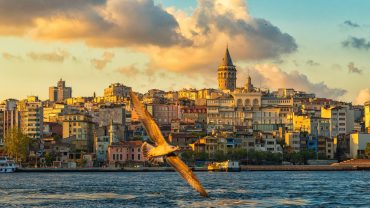
İzmir (US:iz-MEER), often spelled Izmir in English, is a metropolitan city in the western extremity of Anatolia. It is the third most populous city in Turkey, after Istanbul and Ankara; and the second largest urban agglomeration on the Aegean Sea after Athens, Greece. In 2019, the city of İzmir had a population of 2,972,900, while İzmir Province had a total population of 4,367,251. İzmir’s metropolitan area extends along the outlying waters of the Gulf of İzmir and inland to the north across the Gediz River Delta; to the east along an alluvial plain created by several small streams; and to slightly more rugged terrain in the south. In classical antiquity the city was known as Smyrna (smɜːrnə/ SMUR-nə) – a name which remained in use in English and various other languages until around 1930, when government efforts led the original Greek name (Greek: Σμύρνη, romanized: Smýrni/Smýrnē) to be gradually phased out internationally in favor of its Turkish counterpart İzmir. However, the historic name Smyrna is still used today in some languages, Italian (Smirne), and Catalan, Portuguese, and Spanish (Esmirna). Smyrna has more than 3,000 years of recorded urban history, and up to 8,500 years of history as a human settlement since the Neolithic period. Lying on an advantageous location at the head of a gulf running down in a deep indentation, midway along the western Anatolian coast, it has been one of the principal mercantile cities of the Mediterranean Sea for much of its history. İzmir hosted the Mediterranean Games in 1971 and the World University Games (Universiade) in 2005. The city participated in Climathon in 2019. The city of İzmir is composed of several metropolitan districts. Of these, the district of Konak corresponds to historical İzmir, with this district’s area having constituted the city’s central “İzmir Municipality” (Turkish: İzmir Belediyesi) until 1984. With the formation of the “İzmir Metropolitan Municipality” (Turkish: İzmir Büyükşehir Belediyesi), the city of İzmir at first grouped together its eleven (initially nine) urban districts – namely Balçova, Bayraklı, Bornova, Buca, Çiğli, Gaziemir, Güzelbahçe, Karabağlar, Karşıyaka, Konak, and Narlıdere – and later consolidated them with an additional nine of the province’s districts outside the city proper. In 2013, the passing of Act 6360 established all thirty of İzmir Province’s districts as part of İzmir’s metropolitan area.
Main features
İzmir has over 3000 years of recorded urban history and up to 8500 years of history as a human settlement since the Neolithic period. Set in an advantageous location at the head of a gulf in a deep indentation midway along the western Anatolian coast, the city has been one of the principal mercantile ports of the Mediterranean Sea for much of its history. Modern İzmir also incorporates the nearby ancient cities of Ephesus, Pergamon, Sardis and Klazomenai, and centers of international tourism such as Kuşadası, Çeşme, Mordoğan and Foça. When the Ottomans took over İzmir in the 15th century, they did not inherit compelling historical memories, unlike the other key points of the Ottoman trade network, namely Constantinople (Istanbul), Damascus, Baghdad and Cairo. The emergence of İzmir as a major international port by the 17th century was largely a result of the attraction it exercised over foreigners, and the city’s European orientation. Politically, İzmir is considered a stronghold of Kemalism and the Republican People’s Party (CHP). Izmir’s port is Turkey’s primary port for exports in terms of the freight handled and its free zone, a Turkish-U.S. joint-venture established in 1990, is the leader among the twenty in Turkey. The workforce, and particularly its rising class of young professionals, is concentrated either in the city or in its immediate vicinity (such as in Manisa and Turgutlu), and as either larger companies or SMEs, affirm their names with an increasingly wider global scale and intensity. İzmir hosted the Mediterranean Games in 1971 and the World University Games (Universiade) in 2005. In March 2008, İzmir submitted its bid to the BIE for hosting the Universal Expo 2015, but it was won by Milan, Italy.
History
Ancient times
The city is one of the oldest settlements of the Mediterranean basin. The 2004 discovery of Yeşilova Höyük and the neighboring Yassıtepe, in the small delta of Meles River, now the Bornova plain, reset the starting date of the city’s past further back than previously thought. Findings from two seasons of excavations carried out in the Yeşilova Höyük by a team of archaeologists from İzmir’s Ege University indicate three levels, two of which are prehistoric. Level 2 bears traces of early to mid-Chalcolithic, and Level 3 of Neolithic settlements. These two levels would have been inhabited by the indigenous peoples of the area, very roughly, between 7th millennium BC to 4th millennium BC. As the seashore receded with time, the site was later used as a cemetery. Several graves containing artifacts dating roughly from 3000 BC, and contemporary with the first city of Troy, were found. The first settlement to have commanded the Gulf of İzmir as a whole was established on top of Mount Yamanlar, to the northeast of the inner gulf. In connection with the silt brought by the streams which join the sea along the coastline, the settlement to form later the core of “Old Smyrna” was founded on the slopes of the same mountain, on a hill (then a small peninsula connected to the mainland by a small isthmus) in the present-day neighborhood of Tepekule in Bayraklı. The Bayraklı settlement is thought to have stretched back in time as far as the 3rd millennium BC. Archaeological findings of the late Bronze Age show a certain decree of Mycenaean influence in the settlement and the surrounding region, though further excavations of Bronze Age layers are needed to propose
Old Smyrna of that time as a Mycenaean settlement. In the 13th century BC, however, invasions from the Balkans (the so-called Sea Peoples) destroyed Troy VII, and Central and Western Anatolia as a whole fell into what is generally called the period of “Anatolian” and “Greek” Dark Ages of the Bronze Age collapse.
Old Smyrna
At the dawn of İzmir’s recorded history, Pausanias describes “evident tokens” such as “a port called after the name of Tantalus and a sepulchre of him by no means obscure”, corresponding to the city’s area and which have been tentatively located to date. The term “Old Smyrna” is used to describe the Archaic Period city located at Tepekule, Bayraklı, to make a distinction with the city of Smyrna rebuilt later on the slopes of Mount Pagos (present-day Kadifekale). The Greek settlement in Old Smyrna is attested by the presence of pottery dating from about 1000 BC onwards. The most ancient ruins preserved to our times date back to 725–700 BC. According to Herodotus the city was founded by Aeolians and later seized by Ionians. The oldest house discovered in Bayraklı has been dated to 925 and 900 BC. The walls of this well-preserved house (2.45 by 4 metres or 8.0 by 13.1 feet), consisting of one small room typical of the Iron Age, were made of sun-dried bricks and the roof of the house was made of reeds. The oldest model of a multiple-roomed house of this period was found in Old Smyrna. Known to be the oldest house having so many rooms under its roof, it was built in the second half of the 7th century BC. The house has two floors and five rooms with a courtyard. Around that time, people started to build thick, protective ramparts made of sun-dried bricks around the city. Smyrna was built on the Hippodamian system, in which streets run north-south and east-west and intersect at right angles, in a pattern familiar in the Near East but the earliest example in a western city. The houses all faced south. The most ancient paved streets in the Ionian civilization have also been discovered in ancient Smyrna. Homer, referred to as Melesigenes meaning “Child of the Meles Brook”, is said to have been born in Smyrna in the 7th or 8th century BC. Combined with written evidence, it is generally admitted that Smyrna and Chios put forth the strongest arguments in claiming Homer and the main belief is that he was born in Ionia. A River Meles, still bearing the same name, is located within the city limits, although associations with the Homeric river is subject to controversy. From the 7th century onwards, Smyrna achieved the identity of a city-state. About a thousand people lived inside the city walls, with others living in nearby villages, where fields, olive trees, vineyards, and the workshops of potters and stonecutters were located. People generally made their living from agriculture and fishing. The most important sanctuary of Old Smyrna was the Temple of Athena, which dates back to 640–580 BC and is partially restored today. Smyrna, by this point, was no longer a small town, but an urban center taking part in the Mediterranean trade. The city eventually became one of the twelve Ionian cities and was well on its way to becoming a foremost cultural and commercial center in the Mediterranean basin of that period, reaching its peak between 650–545 BC.
Modern times
Following the defeat of the Ottoman Empire in World War I, the victors had, for a time, intended to carve up large parts of Anatolia into respective zones of influence and offered the western regions of Turkey to Greece under the Treaty of Sèvres. On 15 May 1919, the Greek Army landed in Smyrna, but the Greek expedition towards central Anatolia was disastrous for both that country and for the local Greeks of Anatolia. By September 1922 the Greek army had been defeated and was in full retreat, the last Greek soldiers leaving Smyrna on 8 September 1922. The Turkish Army retook possession of the city on 9 September 1922, effectively ending the Greco-Turkish War (1919–1922). Four days later, on 13 September 1922, a great fire broke out in the city, lasting until 22 September. The fire completely destroyed the Greek and Armenian quarters, while the Muslim and Jewish quarters escaped damage. Estimated Greek and Armenians deaths resulting from the fire range from 10,000 to 100,000 Approximately 50,000 to 400,000 Greek and Armenian refugees crammed the waterfront to escape from the fire and were forced to remain there under harsh conditions for nearly two weeks. The systematic evacuation of Greeks on the quay started on 24 September when the first Greek ships entered the harbor under the supervision of Allied destroyers. Some 150,000 to 200,000 Greeks were evacuated in total. The remaining Greeks left for Greece in 1923, as part of the population exchange between Greece and Turkey, a stipulation of the Treaty of Lausanne, which formally ended the Greco-Turkish War. The war, and especially the events that took place in İzmir, such as the fire, probably the greatest disaster the city has ever experienced, continue to influence the psyches of the two nations to this day. The Turks have claimed that the Greek army landing was marked from the very first day by the “first bullet” fired on Greek detachments by the journalist Hasan Tahsin and the bayonetting to death of Colonel Fethi Bey and his unarmed soldiers in the city’s historic barracks (Sarı Kışla — the Yellow Barracks), for refusing to shout “Zito o Venizelos” (“Long Live Venizelos”). The Greeks, on the other hand, have cited the numerous atrocities committed by the Turkish soldiers against the Greeks and Armenians (locals or hinterland refugees) in İzmir. These include the lynching of the Orthodox Metropolitan Chrysostomos following the recapture of the city on 9 September 1922 and the slaughter of Armenian and Greek males, who were then sent to the so-called labour battalions. The city was, once again, gradually rebuilt after the proclamation of the Turkish Republic in 1923. In 2020, the city was damaged by the Aegean Sea earthquake, which so far is the deadliest earthquake of 2020. As of 2 November 2020, the earthquake had caused 91 deaths and 994 injuries in İzmir.
Climate
İzmir has a Mediterranean climate (Köppen climate classification: Csa), which is characterized by prolonged, hot, and dry summers, and mild to cool, rainy winters. The total precipitation for İzmir averages 695.4 mm (27.38 in) per year; however, the vast majority of the city’s rainfall occurs from November through March. The rest of the precipitation generally falls during April through May and September through October. There is usually very little to no rainfall from June through August, with frequent summer droughts. The city received its greatest rainfall, 145.3 mm (5.72 in), on September 29, 2006, while the highest wind speed of 127.1 km/h (79.0 mph) was recorded on March 29, 1970. Maximum temperatures during the winter months are mostly between 10 and 16 °C (50 and 61 °F). Although it is rare, snow can fall in İzmir from December to February, staying for a period of hours rather than a whole day or more, with a record 32 cm (13 in) of snow depth recorded on January 31, 1945. During summer, the air temperature can climb as high as 40 °C (104 °F) from June to September; however, the high temperatures are usually between 30 and 36 °C (86 and 97 °F).
Main sights
Standing on Mount Yamanlar, the tomb of Tantalus was excavated by Charles Texier in 1835 and is an example of the historic traces in the region prior to the Hellenistic Age, along with those found in nearby Kemalpaşa and Mount Sipylus. The Agora of Smyrna is well preserved, and is arranged into the Agora Open Air Museum of İzmir, although important parts buried under modern buildings wait to be brought to light. Serious consideration is also being given to uncovering the ancient theatre of Smyrna where St. Polycarp was martyred, buried under an urban zone on the slopes of Kadifekale. It was distinguishable until the 19th century, as evident by the sketches done at the time. At top of the same hill stands an ancient castle, one of İzmir’s landmarks. One of the more pronounced elements of İzmir’s harbor is the Clock Tower, a marble tower in the middle of the Konak district, standing 25 m (82 ft) in height. It was designed by Levantine French architect Raymond Charles Père in 1901 to commemorate the 25th anniversary of the ascension of Abdülhamid II to the Ottoman throne in 1876. The tower features four fountains placed around the base in a circular pattern, and the columns are inspired by North African themes. The Kemeraltı bazaar zone set up by the Ottomans, combined with the Agora, rests near the slopes of Kadifekale. İzmir has had three castles historically – Kadifekale (Pagos), the portuary Ok Kalesi (Neon Kastron, St. Peter), and Sancakkale, which remained vital to İzmir’s security for centuries. Sancakkale is situated in the present-day İnciraltı quarter between the Balçova and Narlıdere districts, on the southern shore of the Gulf of İzmir. It is at a key point where the strait allows entry into the innermost tip of the Gulf at its narrowest, and due to shallow waters through a large part of this strait, ships have sailed close to the castle. There are nine synagogues in İzmir, concentrated either in the traditional Jewish quarter of Karataş or in Havra Sokak (Synagogue street) in Kemeraltı, and they all bear the signature of the 19th century when they were built or re-constructed in depth on the basis of former buildings. The Atatürk Mask (Turkish: Atatürk Maskı) is a large concrete relief of the head of Mustafa Kemal Atatürk, founder of modern Turkey, located to the south of Kadifekale the historical castle of İzmir. The İzmir Bird Paradise (Kuş Cenneti) in Çiğli, a bird sanctuary near Karşıyaka, has recorded 205 species of birds, including 63 species that are resident year-round, 54 species of summer migratory birds, 43 species of winter migratory birds, and 30 transient species. 56 species of birds have bred in the park. The sanctuary, which covers 80 square kilometres, was registered as “the protected area for water birds and for their breeding” by the Turkish Ministry of Forestry in 1982. A large open-air zoo was established in the same district of Çiğli in 2008 under the name Sasalı Park of Natural Life.
İzmir International Fair
İzmir prides itself with its busy schedule of trade fairs, exhibitions and congresses. The fair and the festival are held in the compound of İzmir’s vast inner city park named Kültürpark in the first days of September, and organized by İZFAŞ, a depending company of İzmir Metropolitan Municipality.





Comment (0)